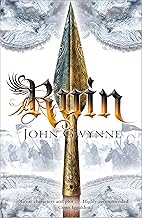
Review of Ruin: The Faithful and the Fallen 03 by John Gwynne
Ruin, the third book in John Gwynne’s The Faithful and the Fallen series, is a masterful continuation of an epic tale filled with battles, betrayals, complex characters, and moral dilemmas. The novel stands as one of the most exhilarating and emotionally charged installments in the series, leaving readers on the edge of their seats while providing an intricate tapestry of character arcs and world-building.
Plot Overview
The story picks up where Valor, the second book, left off. The forces of good and evil continue to clash, with the fate of the Banished Lands hanging in the balance. The light side, represented by the forces of the good kings and warriors, are still in pursuit of defeating the dark forces led by the enigmatic and powerful karn (the dark one). At the same time, characters from both sides continue to evolve, often torn between their personal desires and larger ideological battles.
Ruin focuses on key events such as battles, alliances, and personal sacrifices, highlighting the increasing stakes for each character involved. The book takes readers on a deep dive into the characters' psychological and emotional turmoil, offering intricate plot developments, where no side remains completely virtuous or wholly villainous.
Character Development
One of the most impressive aspects of Ruin is the continued development of its vast array of characters. Gwynne has built an expansive world, and his characters feel real and multidimensional. The central protagonist, Corban, continues to evolve as a leader, grappling with the burdens of responsibility, leadership, and his own sense of morality. His transformation from a young warrior to someone who must make life-changing decisions is compelling, and it’s clear that the weight of his choices will carry significant consequences for the entire realm.
Meanwhile, other characters like Veradis, Ruth, and Vafor also have complex arcs that delve into their personal dilemmas. Veradis’s inner conflict regarding loyalty, ambition, and honor becomes more apparent in Ruin, leading to some truly pivotal moments in the story. Ruth’s journey continues to be an emotional one as she navigates her struggles with faith and trust.
What makes these characters so engaging is that Gwynne refuses to paint them as mere archetypes of good or evil. Instead, he portrays them as deeply human, filled with flaws, doubts, and moments of grace. This complexity leads to morally grey decisions, where both heroes and villains must come to terms with the results of their actions.
World-Building and Themes
Gwynne’s world-building is another standout aspect of Ruin. The Banished Lands remain richly detailed, with a fantastic sense of history and mythology that permeates the narrative. The world itself is in a constant state of tension, with long-standing political, religious, and cultural divides that add depth to the plot. The author continues to develop the unique traits of each region and people, making the setting feel vast and alive.
Themes of loyalty, betrayal, sacrifice, and the question of destiny versus free will are explored in Ruin with greater depth than in the previous books. The novel interrogates the idea of what it means to be a hero or a villain, challenging the reader to reflect on how personal actions fit into the grander scheme of war and history. The spiritual and religious elements also continue to be woven throughout the book, as characters confront their beliefs in the face of overwhelming trials.
Action and Pacing
If you’re looking for action, Ruin does not disappoint. The battle scenes are intense and well-executed, filled with strategic maneuvering, tension, and emotional weight. Gwynne has a gift for balancing large-scale action with the personal stakes of his characters, making every fight feel meaningful. The pacing of the novel is consistent, with a good balance of quieter character moments, political intrigue, and thrilling combat.
While Ruin does have its share of large battles, it also provides quieter moments of reflection, where characters are allowed to grapple with their inner turmoil. These moments create a great contrast to the action-heavy chapters, and as a result, the book never feels rushed or overly dependent on spectacle. The emotional beats hit hard, and the payoffs are rewarding.
Conclusion
Ruin is an exceptional continuation of The Faithful and the Fallen series. John Gwynne has successfully built upon the strong foundations laid in the first two books, creating a tale that is more nuanced, emotionally impactful, and unpredictable. The growth of characters like Corban and Veradis makes this book particularly engaging, as their individual journeys are filled with personal sacrifice, moral struggle, and difficult choices.
The intricate world-building, the deeply human themes, and the exciting action make Ruin a must-read for fans of epic fantasy. If you enjoyed the first two books in the series, you’ll find that Ruin elevates the story to new heights, with its captivating characters, thrilling action, and heart-wrenching dilemmas.
For those new to the series, starting with Malice (book one) and working through the progression is highly recommended, as it’s an immensely rewarding journey through one of the most well-crafted fantasy universes in recent years. Ruin leaves readers eagerly anticipating the next chapter in the Faithful and the Fallen saga.
- Hits: 327
Movies
Action
Adventure
Animation
Comedy
Crime
Documentary
Drama
Family
Sci-Fi & Fantasy
TV Shows
Action
Adventure
Animation
Comedy
Crime
Documentary
Drama
Family
Sci-Fi & Fantasy
History
Alabama
Travels
Alabama






































































































